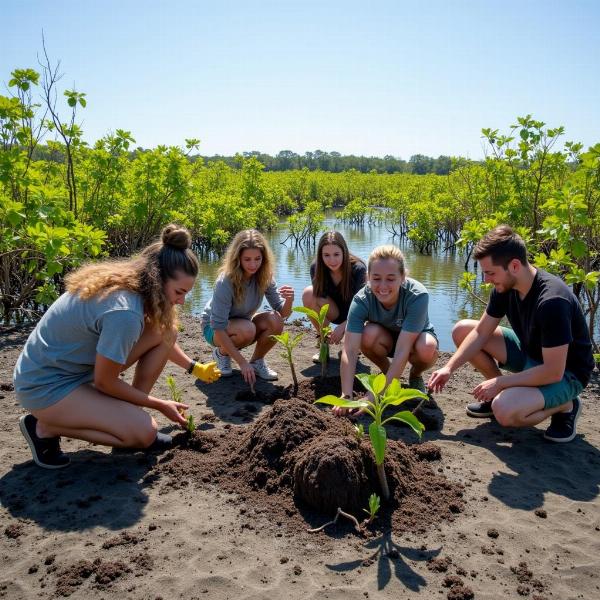Tidal forests, also known as mangrove forests, are unique and fascinating ecosystems found in coastal regions where freshwater meets saltwater. Understanding the “tidal forest meaning in Hindi” opens a window into a world teeming with specialized flora and fauna adapted to this challenging environment. But what exactly does “tidal forest” mean in Hindi? Let’s dive in.
Exploring the Hindi Terminology for Tidal Forest
The most common Hindi term for tidal forest is “सुंदरी वन” (Sundari Van). “Sundari” refers to the Sundari tree (Heritiera fomes), a dominant species in these forests, while “Van” means forest. Another term used is “मैंग्रोव वन” (Mangrove Van), a direct transliteration of “mangrove forest.” Sometimes, you might also encounter “ज्वारीय वन” (Jwariy Van), where “Jwariy” relates to tides, accurately reflecting the tidal influence on these ecosystems.
Characteristics of Tidal Forests
Tidal forests thrive in intertidal zones, areas regularly flooded by tides. These harsh conditions, with fluctuating salinity and oxygen levels, demand unique adaptations from the resident species. Mangroves, the dominant vegetation, have developed specialized root systems like pneumatophores (breathing roots) and prop roots for stability and oxygen absorption.
What makes these forests so special? Their ability to tolerate saline water, their role as a natural barrier against coastal erosion, and their rich biodiversity are just a few examples. They provide a crucial habitat for numerous species of fish, crustaceans, birds, and even mammals.
Significance of Tidal Forests in India
India boasts a significant area under tidal forest cover, particularly along the eastern coast and in the Andaman and Nicobar Islands. The Sundarbans, shared between India and Bangladesh, is the largest single block of tidal forest in the world, renowned for its Royal Bengal tigers. These forests play a vital role in the livelihoods of coastal communities, providing resources like timber, fuelwood, and fish. They also serve as a crucial defense against cyclones and storm surges, protecting coastal populations and infrastructure.
Threats to Tidal Forests
Despite their importance, tidal forests face increasing threats from human activities and climate change. Deforestation for agriculture, aquaculture, and urban development is a major concern. Pollution from industrial and agricultural runoff further degrades the water quality, impacting the delicate balance of the ecosystem. Sea level rise due to climate change also poses a significant threat, potentially submerging large areas of these vital forests.
Conservation Efforts
Recognizing the importance of tidal forests, various conservation efforts are underway. These include promoting sustainable management practices, establishing protected areas, and raising awareness about the ecological and economic value of these unique ecosystems. Understanding the “tidal forest meaning in Hindi” and the significance of these forests is the first step towards their preservation.
 Volunteers planting mangrove saplings in a conservation project
Volunteers planting mangrove saplings in a conservation project
Conclusion: Protecting Our Coastal Guardians
Tidal forests, or Sundari Van, are vital ecosystems that play a crucial role in coastal protection, biodiversity conservation, and the livelihoods of local communities. Understanding their significance and the threats they face is essential for their preservation. By working together, we can protect these invaluable coastal guardians for future generations.
FAQ
- What is the main difference between a tidal forest and a regular forest? Tidal forests grow in intertidal zones, regularly inundated by saltwater, unlike regular forests that thrive on land. Mangroves, with their specialized adaptations, are the dominant vegetation in tidal forests.
- Why are tidal forests important for coastal protection? They act as a natural barrier, reducing the impact of waves, storms, and erosion.
- What is the largest tidal forest in the world? The Sundarbans, located in India and Bangladesh.
- What are the main threats to tidal forests? Deforestation, pollution, and sea level rise.
- How can I contribute to tidal forest conservation? Support organizations working on mangrove conservation, participate in local cleanup drives, and spread awareness about the importance of these ecosystems.
- What are some common animals found in tidal forests? Fish, crabs, shrimps, birds, crocodiles, and even tigers in some regions like the Sundarbans.
- Are tidal forests important for the economy? Yes, they provide resources like timber, fuelwood, and fish, supporting the livelihoods of coastal communities.
Meaning-Hindi.in is your trusted partner for accurate and culturally sensitive translations. Specializing in various fields, from business and legal documents to technical manuals and website localization, we offer high-quality Hindi translation services tailored to your specific needs. Whether you need to translate your educational materials or require urgent translation services, Meaning-Hindi.in‘s team of expert linguists ensures precision and fluency. Contact us today at [email protected] or call us at +91 11-4502-7584. Let Meaning-Hindi.in bridge the language gap for you.